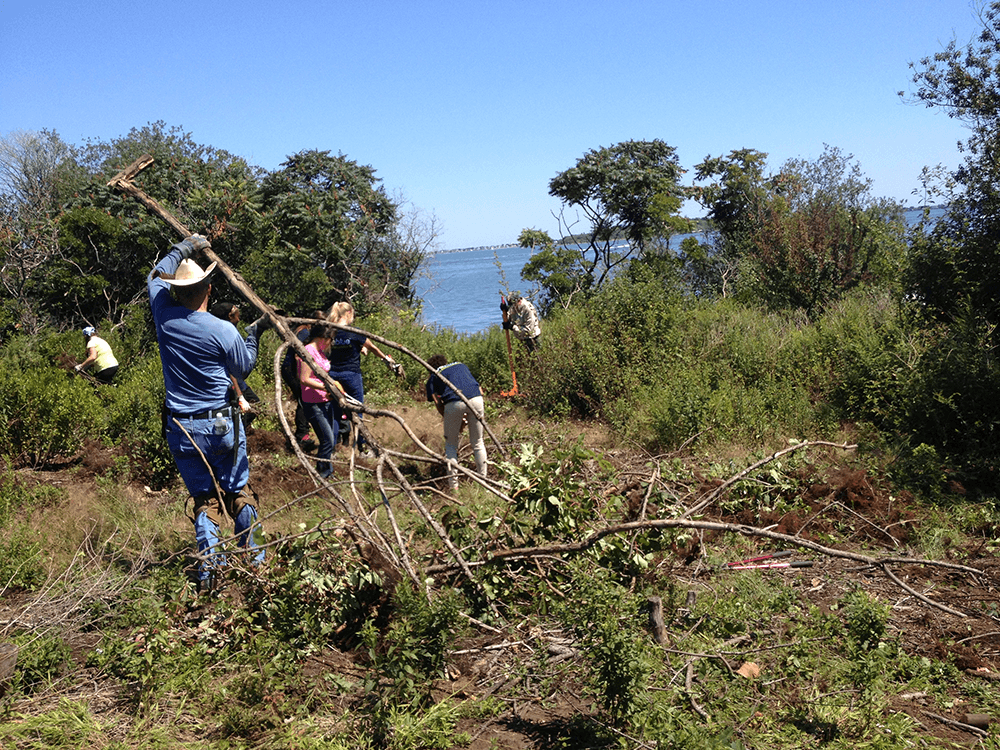These volunteer weed whackers are fighting invaders in Boston’s harbor
Volunteer Bob Walsh drags away buckthorn branches.
There are many groups and efforts dedicated to conserving threatened wildlife and plant species. One group of environmentally-conscious volunteers in Boston, Massachusetts, however, is not afraid of getting their hands dirty to take care of their local eco-system.
Marc Albert is director of “Stewardship Saturday” a 10-year-old weekly tradition of local conservation on the Boston Harbor Islands.
“Other park managers and I wanted to offer the public an opportunity to sort of be hands-on with helping to take care of the park,” Albert says.
On a recent Saturday morning, Albert led a dozen or so volunteers on a boat trip to Grape Island — a land mass in Boston Harbor covered with lush vegetation, hiking trails and campsites. Locals infamously call it Tick Island.
After slathering themselves with bug spray, Albert’s group of volunteers heads for the woods, and dense vegetation on the island. They are searching for glossy buckthorn, a viciously persistent invasive shrub species with small fruits and dark, oblong leaves. When they find one of the plants, a pair of volunteers pulls it up by the stem, trying not to disturb other plants in the area.
Albert says the sea buckthorn, along with other invasive species, are threatening the ecosystems on the Boston Harbor Islands, and destroying local biodiversity.
“There’s a lot of invasive species that have changed the ecosystems in a way that we end up with sort of the same mix of invasive species here in the Boston Harbor Islands that you might find in a park outside of Philadelphia or even further to the west and south of here,” Albert says.
One of the signature native species in Boston Harbor is the staghorn sumac, a species of flowering plant whose leaves turn bright colors in the fall. Historically, Native Americans soaked the plant’s fuzzy red berries to make a lemon-flavored tea, and dried its leaves to extend their tobacco. Albert says that pulling out the invasive plants will help the staghorn sumac return to the islands.
“Part of what we’re responsible to do in the National Park Service is to preserve the connections to the past, to help tell the stories of people and how they’ve interacted with places overtime. Probably our signature native species here is staghorn sumac. Native Americans utilized staghorn sumac for millennia here in the harbor islands. And without the staghorn sumac being present, it’s hard to feel and understand the deep history of this place,” Albert says.
Albert and his Stewardship Saturday volunteers don't just focus on plant species, they also monitor animal species in the water, and pass their observations on to the Massachusetts Office of Coastal Zone Management.
The Stewardship Sunday volunteers come from a range of backgrounds and ages, and none of them seem to mind the long hours spent tramping across the islands on their days off from work and school. Some of them have been with the program for nearly a decade, and come back week after week. Others are high school students from the New England Aquarium’s Live Blue Ambassador program.
“When I grow up I want to, you know, set an example, and also get out there. I don’t want to be just another person that’s walking on the Earth. I want to make a difference; I want to leave a mark,” says Hereesa, one of the high schoolers.
This story first aired as an interview on PRI's Living on Earth with Steve Curwood.
